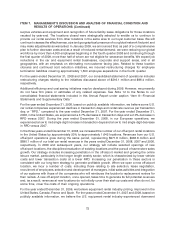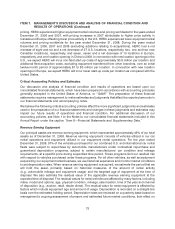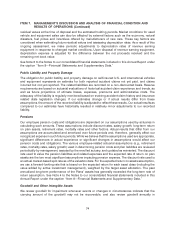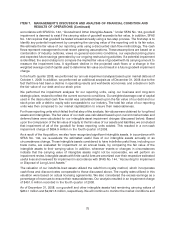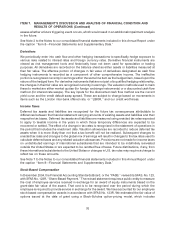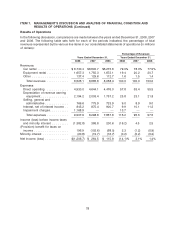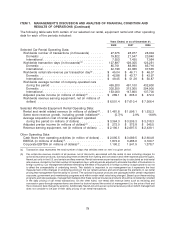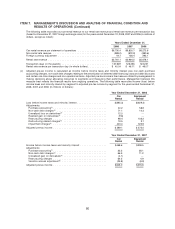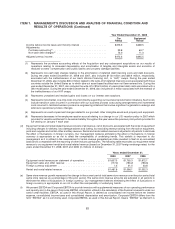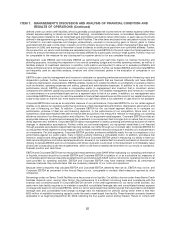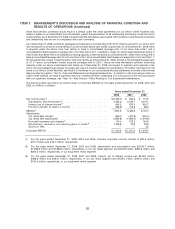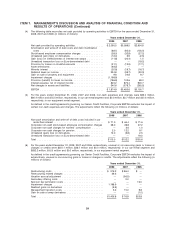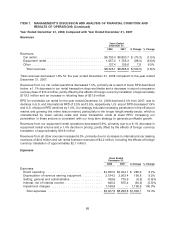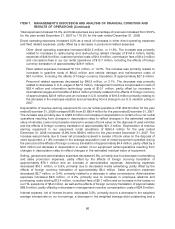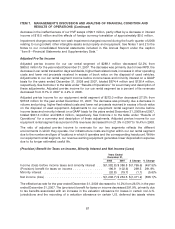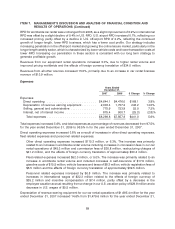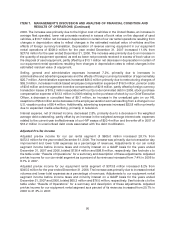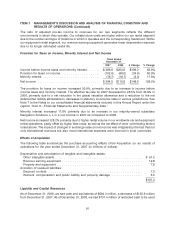Hertz 2008 Annual Report Download - page 102
Download and view the complete annual report
Please find page 102 of the 2008 Hertz annual report below. You can navigate through the pages in the report by either clicking on the pages listed below, or by using the keyword search tool below to find specific information within the annual report.ITEM 7. MANAGEMENT’S DISCUSSION AND ANALYSIS OF FINANCIAL CONDITION AND
RESULTS OF OPERATIONS (Continued)
defined under our senior credit facilities, which is generally consolidated net income before net interest expense (other than
interest expense relating to certain car rental fleet financing), consolidated income taxes, consolidated depreciation (other
than depreciation related to the car rental fleet) and amortization and before certain other items, in each case as more fully
defined in the agreements governing our Senior Credit Facilities. The other items excluded in this calculation include, but are
not limited to: non-cash expenses and charges; extraordinary, unusual or non-recurring gains or losses; gains or losses
associated with the sale or write-down of assets not in the ordinary course of business; certain management fees paid to the
Sponsors in 2006; and earnings to the extent of cash dividends or distributions paid from non-controlled affiliates. Further,
the covenants in our senior credit facilities are calculated using Corporate EBITDA for the most recent four fiscal quarters as a
whole. As a result, the measure can be disproportionately affected by a particularly strong or weak quarter. Further, it may not
be comparable to the measure for any subsequent four-quarter period or for any complete fiscal year.
Management uses EBITDA and Corporate EBITDA as performance and cash flow metrics for internal monitoring and
planning purposes, including the preparation of our annual operating budget and monthly operating reviews, as well as to
facilitate analysis of investment decisions. In addition, both metrics are important to allow us to evaluate profitability and
make performance trend comparisons between us and our competitors. Further, we believe EBITDA and Corporate EBITDA
are frequently used by securities analysts, investors and other interested parties in the evaluation of companies in our
industries.
EBITDA is also used by management and investors to evaluate our operating performance exclusive of financing costs and
depreciation policies. Further, because we have two business segments that are financed differently and have different
underlying depreciation characteristics, EBITDA enables investors to isolate the effects on profitability of operating metrics
such as revenue, operating expenses and selling, general and administrative expenses. In addition to its use to monitor
performance trends, EBITDA provides a comparative metric to management and investors that is consistent across
companies with different capital structures and depreciation policies. This enables management and investors to compare
our performance on a consolidated basis and on a segment basis to that of our peers. In addition, our management uses
consolidated EBITDA as a proxy for cash flow available to finance fleet expenditures and the costs of our capital structure on
a day-to-day basis so that we can more easily monitor our cash flows when a full statement of cash flows is not available.
Corporate EBITDA also serves as an important measure of our performance. Corporate EBITDA for our car rental segment
enables us to assess our operating performance inclusive of fleet management performance, depreciation assumptions and
the cost of financing our fleet. In addition, Corporate EBITDA for our car rental segment allows us to compare our
performance, inclusive of fleet mix and financing decisions, to the performance of our competitors. Since most of our
competitors utilize asset-backed fleet debt to finance fleet acquisitions, this measure is relevant for evaluating our operating
efficiency inclusive of our fleet acquisition and utilization. For our equipment rental segment, Corporate EBITDA provides an
appropriate measure of performance because the investment in our equipment fleet is longer-term in nature than for our car
rental segment and, therefore, Corporate EBITDA allows management to assess operating performance exclusive of interim
changes in depreciation assumptions. Further, unlike our car rental segment, our equipment rental fleet is not financed
through separate securitization-based fleet financing facilities, but rather through our corporate debt. Corporate EBITDA for
our equipment rental segment is a key measure used to make investment decisions because it enables us to evaluate return
on investments. For both segments, Corporate EBITDA provides a relevant profitability metric for use in comparison of our
performance against our public peers, many of whom publicly disclose a comparable metric. In addition, we believe that
investors, analysts and rating agencies consider EBITDA and Corporate EBITDA useful in measuring our ability to meet our
debt service obligations and make capital expenditures. Several of our material debt covenants are based on financial ratios
utilizing Corporate EBITDA and non-compliance with those covenants could result in the requirement to immediately repay
all amounts outstanding under those agreements, which could have a material adverse effect on our results of operations,
financial position and cash flows.
EBITDA and Corporate EBITDA are not recognized measurements under GAAP. When evaluating our operating performance
or liquidity, investors should not consider EBITDA and Corporate EBITDA in isolation of, or as a substitute for, measures of
our financial performance and liquidity as determined in accordance with GAAP, such as net income, operating income or net
cash provided by operating activities. EBITDA and Corporate EBITDA may have material limitations as performance
measures because they exclude items that are necessary elements of our costs and operations.
Because other companies may calculate EBITDA and Corporate EBITDA differently than we do, EBITDA may not be, and
Corporate EBITDA as presented in this Annual Report is not, comparable to similarly titled measures reported by other
companies.
Borrowings under our Senior Credit Facilities are a key source of our liquidity. Our ability to borrow under these Senior Credit
Facilities depends upon, among other things, the maintenance of a sufficient borrowing base and compliance with the
financial ratio covenants based on Corporate EBITDA set forth in the credit agreements for our senior credit facilities. Our
senior term loan facility requires us to maintain a specified consolidated leverage ratio and consolidated interest expense
coverage ratio based on Corporate EBITDA, while our senior asset-based loan facility requires that a specified consolidated
leverage ratio and consolidated fixed charge coverage ratio be maintained for periods during which there is less than
$200 million of available borrowing capacity under the senior asset-based loan facility. These financial covenants became
applicable to us beginning September 30, 2006, reflecting the four quarter period ending thereon. Failure to comply with
82


